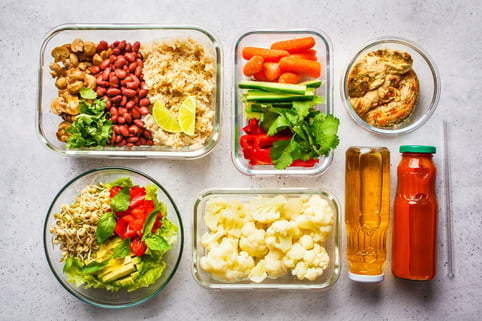 “Aim to consume a diet that is high in fruits and vegetables.”
“Aim to consume a diet that is high in fruits and vegetables.”
“Make half of your plate a fruit and vegetable.”
“Consume 5 to 6 servings of vegetables and fruits every day.”
This nutrition advice has been the standard from physicians, food and nutrition scientists, and even dietitians. However recent research is revealing that just as important as quantity may be the diversity of your diet. What fruits and vegetables do you pick up from the store on a weekly basis? Do you spend a significant amount of time in the produce section and fill your cart with plant foods? Or do you end up lingering for half an hour in the center aisles and packing your cart with processed food products?
The SAD Truth About the Standard American Diet
Check out these scary statistics… The standard American diet (termed the “SAD diet”) is often very high in animal protein, saturated fats, added sugar, and refined/processed foods. In fact, it is estimated that the average American consumes 32% of their calories from animal foods, 57% from processed foods, and only 11% from whole grains, beans, fruits, vegetables, and nuts (Source: USDA). Three out of four Americans don’t eat a single piece of fruit in a given day, and nearly 9 out of 10 don’t reach the minimum recommended daily intake of vegetables (Source: National Cancer Institute)!
Promote Gut Health with Whole Plant Foods
To create a healthy gut microbiome (meaning the trillions of bacteria that live in your digestive tract), increase the variety of whole, plant foods in your diet. The American Gut Project found that individuals who ate 30 or more different types of plant foods every week had gut microbiomes that were more diverse than those who ate 10 or fewer types of plant foods every week. A healthful plant-based diet improves the health and diversity of your gut microbes and may help prevent conditions like obesity, heart disease, inflammation, and diabetes by turning the genes on and off that affect these conditions.
How to Eat More Fruits and Vegetables
I often find myself picking out the same fruits and veggies every week, and this has made me stop and think about what’s in my shopping cart—if I bring it home, I will usually eat it! Freezing fruit and veggies is also a great way to make sure nothing goes to waste before it’s used. Below I offer some advice on how to add more plant foods into your weekly routine. I would also like to challenge you to see how many different fruits and vegetables you can eat this week—anything that is a whole plant food and that you eat a decent portion of counts. The goal is to not only increase plant foods in your diet, but also the diversity.
- Aim to include a piece of fruit and one vegetable at every meal—including breakfast! Instead of a fried egg on a piece of bread, scramble the egg with spinach, mushrooms, or onions. For an even bigger impact, replace your egg with soy and make a tofu scramble.
- Eat two meatless meals during the week. Replace your animal protein with beans or lentils, or try making your own veggie burger.
- Make snack time a chance to shine. Skip the vending machine and bring carrot sticks with hummus, a piece of fruit, dehydrated fruit, or mixed nuts.
- Try smoothies. Smoothies are a great way to disguise vegetables if you have trouble hitting your goals. Add spinach, kale, avocado, or celery to a smoothie. The strong flavor of the fruit hides most of the flavor of these greens and eliminates issues with texture many people face with avocado.
- Ditch refined grain products like noodles, white bread, and white rice. Try spaghetti squash or zucchini noodles in place of spaghetti noodles, or try cauliflower “rice” in place of white rice. Instead of crackers or bread, use sliced cucumbers for crackers or Portobello mushrooms, peppers, apples, or lettuce for wraps/bread.
What I’m Eating
Here’s peek at my list of plant foods consumed over the course of three days. You’ll notice a lot of repetition, so by midweek I am still only at about 15 different types of plant foods. I have 15 more to go by the end of the week!
Sunday
- Breakfast: Apple
- Lunch: Lettuce, veggie sushi (asparagus, cucumber, avocado rolls)
- Dinner: N/A (no veggies! Even dietitians sometimes eat just a bowl of cereal—oops!)
Monday
- Breakfast: Rolled oats, banana, ground flax
- Lunch: Roasted asparagus, grapes, avocado (on toast), roasted chickpeas
- Dinner: Kale, red bell pepper, cherry tomato, carrots, roasted chickpeas (all combined as salad and topped with olive oil and lemon juice)
Tuesday
- Breakfast: Rolled oats, strawberries, ground flaxseed
- Lunch: Apple, kale, red bell pepper, cherry tomato, carrots
- Dinner: Roasted asparagus, grapes
Stay tuned for updates on the “30 Plant Foods Challenge” here at NIFS—can we find a member who eats more than 30 plant foods weekly? Do you think you can do it?
This blog was written by Lindsey Hehman, MA, RD, CD. To learn more about the NIFS bloggers, click here.

